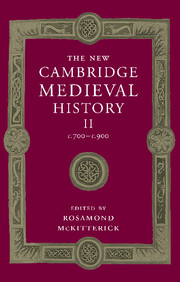Book contents
- Frontmatter
- PART I POLITICAL DEVELOPMENT
- PART II GOVERNMENT AND INSTITUTIONS
- PART III CHURCH AND SOCIETY
- PART IV CULTURE AND INTELLECTUAL DEVELOPMENTS
- 25 Eighth-century foundations
- 26 Language and Communication in Carolingian Europe
- 27 The Carolingian renaissance: education and literary culture
- 28 Theology and the organisation of thought
- 29 Book production in the Carolingian empire and the spread of Caroline minuscule
- 30 Art and architecture
- Conclusion
- Appendix genealogical tables
- List of primary sources
- Bibliography of secondary works arranged by chapter
- Index of manuscripts
- General index
- Frontispiece">
- Plate section
- Map 4 Charlemagne’s Europe and Byzantium, 814
- Map 19 The ecclesiastical provinces of western Europe 700-900
- Map 20 Carolingian schools, scriptoria and literary centres
- Genealogical table X: Wessex
- References
29 - Book production in the Carolingian empire and the spread of Caroline minuscule
from PART IV - CULTURE AND INTELLECTUAL DEVELOPMENTS
Published online by Cambridge University Press: 28 March 2008
- Frontmatter
- PART I POLITICAL DEVELOPMENT
- PART II GOVERNMENT AND INSTITUTIONS
- PART III CHURCH AND SOCIETY
- PART IV CULTURE AND INTELLECTUAL DEVELOPMENTS
- 25 Eighth-century foundations
- 26 Language and Communication in Carolingian Europe
- 27 The Carolingian renaissance: education and literary culture
- 28 Theology and the organisation of thought
- 29 Book production in the Carolingian empire and the spread of Caroline minuscule
- 30 Art and architecture
- Conclusion
- Appendix genealogical tables
- List of primary sources
- Bibliography of secondary works arranged by chapter
- Index of manuscripts
- General index
- Frontispiece">
- Plate section
- Map 4 Charlemagne’s Europe and Byzantium, 814
- Map 19 The ecclesiastical provinces of western Europe 700-900
- Map 20 Carolingian schools, scriptoria and literary centres
- Genealogical table X: Wessex
- References
Summary
If we were to inspect a beautiful writing somewhere, it would not suffice for us to praise the hand of the writer, because he formed the letters even, equal and elegant, if we did not also read the information he conveyed to us by those letters.
(Augustine in Iohannis Evangelium Tractatus, ed. R. Willems (CCSL 36), Turnhout (1954), xxiv, 2)the reigns of Charlemagne and Louis the Pious saw a remarkable expansion in the copying of manuscripts throughout the Carolingian empire and a steady increase in uniformity about the choice of scripts in which texts were copied. Some 500 manuscripts survive from Merovingian Gaul copied before c. 750: some 7000 manuscripts survive copied in the Carolingian empire between c. 750 and 900. Without this expansion, patristic, classical and vernacular writings would not have been studied in the ninth century or read in our own. Because many of the kinds of books and the literary standards of the Roman empire, with its booksellers, law-schools and letter-writers, were replaced, most of our reconstruction of that earlier literary culture relies on extrapolation from stray references in hagiographical and other sources and scanty manuscript survivals. But since every Carolingian manuscript of an earlier text was a copy, to ignore the implications of the discarded exemplars is to misread this evidence. What is clear is that these exemplars were disparate. Only after the ninth century could readers in the lands of the Carolingian empire find a recognisable and accessibly uniform Latin word in the manuscripts which they used. The diversity of scripts which had characterised Europe in 700 was restricted by Carolingian policies. The choice of scripts, and the extent and nature of book production in Spain, Britain and southern Italy, serve as a reminder of what might have happened without the resources of Carolingian faith and Carolingian power.
Keywords
- Type
- Chapter
- Information
- The New Cambridge Medieval History , pp. 786 - 808Publisher: Cambridge University PressPrint publication year: 1995
References
- 6
- Cited by

